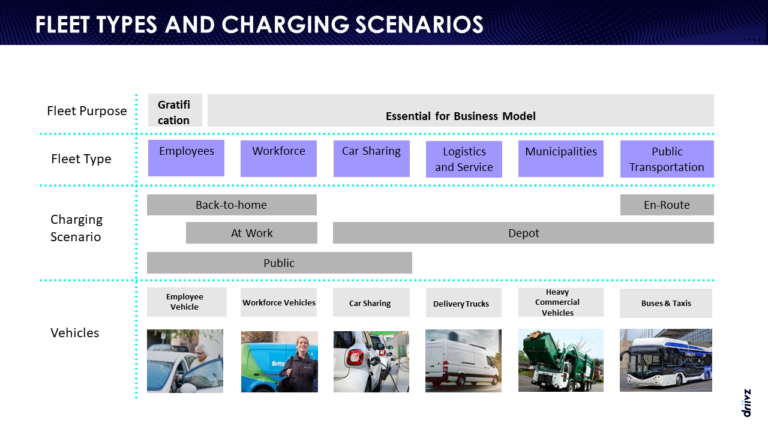Many organizations are already transitioning their fleets from gasoline or natural gas to electric vehicles because of national regulations and policies, tax benefits and subsidies, incentives, reduced TCO for corporate-owned or leased vehicles, avoidance of “pollution penalties,” employee convenience, and a corporate social responsibility policy to reduce carbon emissions.
McKinsey projects that commercial and passenger fleets in the United States alone could include as many as eight million EVs by 2030 (compared with fewer than 5,000 in 2018), which would amount to between 10 and 15 percent of all fleet vehicles.

Once organizations have made the transition decision, it’s time to consider the EV charging infrastructure – hardware, software, energy management, charging logistics, etc.
The first thing to do is to analyze journey patterns their fleet makes and the individual requirements of their fleet type for better planning and implementation.
- Employee vehicles – Employee vehicles can be owned by the employees, leased from the company, or are a perk of the job. While many employees charge at home, others may expect to plug into charging stations in the office parking garage – and have the company pick up the tab (this is considered a benefit and taxed accordingly)
- Workforce fleets – These vehicles are used in service to and owned by the company. Some companies have their employees charge at home (return-to-home-fleet) and reimburse them for electricity consumption; at others, employees leave their work vehicles overnight in the depot, and when they return in the morning, the vehicles are fully charged.
- Delivery vehicles – Based on the type of business, these vehicles may need to leave the loading site at the exact same time, requiring tightly scheduled charging. Others may be “small” enough that they can be charged overnight at the employees’ home. They require enough charge to range between 200 km-400 km on their delivery routes.
- Municipal vehicles – Municipal fleets have a full range of vehicles to manage, everything from the mayor’s personal car to electric sanitation and maintenance trucks, and police patrol vehicles; these may need to travel from a few kilometers to a few hundred in a day. While they may not all be at the fleet charging depot at the same time, the sheer volume makes smart energy and EV charging time management critical.
- Public transportation – Many bus and taxi fleets all over the world are already electric. The volume of buses on the road fluctuates during the day and evening hours, but generally the largest volume of buses awaiting charging will occur in the late evening hours – and all will need to be charged in time to make the morning runs. Taxis fall into two categories – shared vehicles and privately owned. Many cities, including London, have started charging pollution taxes in city centers, so operating EV taxis is less expensive than using traditional gasoline-powered vehicles.
- Car sharing – Car sharing services generally involve short-term, hourly rentals, where the vehicles are picked up and dropped off on the city streets. They may require charging “on the go,” in designated parking spots, or at renter’s worksites.
- Long-haul vehicles – The electrification of large trucks is still in process, but once these become more generally available, they will require both depot-based and en-route charging. Servicing electric trucks on EV charging infrastructure networks requires EV charging and energy management technologies to accelerate the charging speeds and balance electricity demand throughout the charging periods.
Corporations, car rental/leasing agencies, and governments will typically have an EV fleet with predictable driving patterns and thus vehicle or range requirements, combined with an intensive use of vehicles – which would improve TCO of EVs in comparison to ICEs due to lower fuel and maintenance costs.
The Facets of EV Fleet Charging Management
To successfully electrify fleets – beyond the investment in installation and maintenance of chargers – a comprehensive back-end system is essential for the centralized control and management of charging. A back-end system is required to provide fleet managers advanced tools to monitor the status of the electric fleet; remotely diagnose and take proactive activities to resolve charging related issues; access to real-time reporting and analytics and the ability to manage billing and transactions.
In addition, EV fleet operators should be able to reduce their costs by procuring and managing energy in efficient ways. An advanced EV fleet management solution will ideally include a smart energy management solution with demand-response capabilities and support to V2G.
McKinsey estimates that fleet EVs can have a total cost of ownership that is 15 to 25 percent less than that of equivalent ICE vehicles by 2030.

EV Fleet Manager Advanced and Automated Tools
A comprehensive EV fleet charging management solution will keep fleet managers informed of all aspects of EV charging.
A simple and easy to use portal, should support any fleet size, charging at work, home or in a central depot, and provide fleet managers with the tools they need to manage drivers and chargers’ reservations and operations.
It should enable fleet managers to allocate and prioritize charging based on business priorities and available energy sources.
To optimize operations, proactive maintenance algorithms as well as auto-fix capabilities will automatically ensure high availability of the chargers.
Energy Management
Electrifying your fleet will come with energy management challenges, such as lack of visibility into energy levels and consumption and peak-load increases that may require expensive infrastructure upgrades.
An energy management solution will allow fleet managers to prioritize the charging schedule of their fleet based on vehicle tasks, vehicle state-of-charge (SoC), available energy levels and pricing. EV fleet managers would be able to manually configure charging priorities or use algorithm-based prioritization.
EV Fleet Driver Self-service Tools
To enhance EV drivers’ satisfaction, driver self-service tools will typically include registration, reservations, authentication, charging start-stop and customized notifications. With these self-service capabilities tied to the fleet management system, drivers will gain the flexibility to charge anywhere – home, depot, or on-the-road – while being able to be reimbursed for out-of-pocket energy costs.
Summary
No matter the type of business, an EV fleet charging management solution needs to ensure that all EV fleet drivers have fully charged vehicles exactly when they need it – and the grid can handle it.
A comprehensive, futureproof solution will enable EV fleet managers to:
- Reduce TCO
- Ensure chargers’ availability and uptime
- Smartly balance energy usage and optimize existing power infrastructure; directly reduce CAPEX and OPEX by reducing investments in infrastructure and ensuring vehicles can be charged when energy costs are lower.
- Meet greenhouse gas (GHG) reduction regulations
- Gain insights and understanding of costs, trends, and resource utilization.
- Address today and tomorrow’s EV fleet charging management requirements





